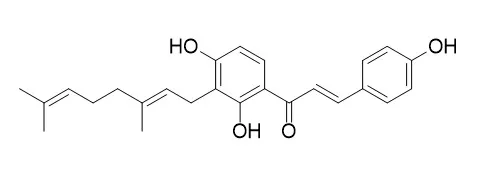| Description: |
Xanthoangelol has anti-inflammatory,anti-platelet and antibacterial activities. It also shows antitumor and/or antimetastatic activities, which may be due to inhibition of DNA synthesis in LLC cells and of tumor-induced neovascularization through inhibition of the formation of capillary-like tubes by vascular endothelial cells and inhibition of the binding of VEGF to vascular endothelial cells. Xanthoangelol may be applicable as an effective drug for treatment of neuroblastoma and leukemia. |
| Targets: |
DNA synthesis | VEGF | Antifection |
| In vitro: |
| Chem Pharm Bull (Tokyo). 1991 Jun;39(6):1604-5. | | Antibacterial activity of two chalcones, xanthoangelol and 4-hydroxyderricin, isolated from the root of Angelica keiskei KOIDZUMI.[Pubmed: 1934181 ] | Two chalcones, Xanthoangelol (I) and 4-hydroxyderricin (II), isolated from the root of Angelica keiskei KOIDZUMI (Umbelliferae) showed antibacterial activity against gram-positive pathogenic bacteria.
METHODS AND RESULTS:
The activity of I on Micrococcus luteus IFO-12708 (minimum inhibitory concentration (MIC), 0.76 microgram/ml) was the same potency as that of gentamicin, which is used as a standard. Although the activity of both chalcones on plant-pathogenic bacteria was lower than that of streptomycin sulfate, used as a positive control, they also exhibited growth-inhibitory effects.
CONCLUSIONS:
The antibacterial activity of I isolated from Angelica keiskei KOIDZUMI is being reported here for the first time. The growth-inhibitory effect of II on plant-pathogenic bacteria is also reported for the first time in this paper. | | Pharmazie. 2016 Nov 2;71(11):651-654. | | Anti-platelet effects of chalcones from Angelica keiskei Koidzumi (Ashitaba) in vivo.[Pubmed: 29441970 ] | Angelica keiskei Koidzumi (Ashitaba) is a traditional folk medicine that is also regarded in Japan as a health food with potential antithrombotic properties. The ability of the major chalcones, Xanthoangelol (XA) and 4-hydroxyderricin (4-HD) extracted from Ashitaba roots to inhibit platelet aggregation activity in vitro was recently determined. However, the anti-platelet activities of Ashitaba chalcones in vivo have remained unclear.
METHODS AND RESULTS:
The present study examines the anti-platelet effects of Ashitaba exudate and its constituent chalcones using mouse tail-bleeding models that reflect platelet aggregation in vivo. Ashitaba exudate and the major chalcone subtype XA, suppressed the lipopolysaccharide (LPS)-induced shortening of mouse tail bleeding. However, trace amounts of other Ashitaba chalcone subtypes including Xanthoangelols B (XB), D (XD), E (XE) and F (XF) did not affect tail bleeding.
CONCLUSIONS:
These results suggest that the major chalcone subtype in Ashitaba, XA, has anti-platelet-activities in vivo. |
|
| In vivo: |
| Int J Cancer. 2003 Sep 1;106(3):429-37. | | Antitumor and antimetastatic activities of Angelica keiskei roots, part 1: Isolation of an active substance, xanthoangelol.[Pubmed: 12845685 ] | The roots of Angelica keiskei Koizumi have traditionally been used as a health food, with diuretic, laxative, analeptic and galactagogic effects. It has been thought that the roots and leaves of A. keiskei have preventive effects against coronary heart disease, hypertension and cancer. In the present study, we examined the antitumor and antimetastatic activities of various fractions isolated from a 50% ethanol extract of A. keiskei roots.
METHODS AND RESULTS:
The ethyl acetate-soluble fraction of the 50% ethanol extract inhibited tumor growth in LLC-bearing mice at a daily dose of 100 mg/kg prolonged survival time and inhibited metastasis to the lung after surgical removal of primary tumors. Two active substances were isolated from fractions 1 and 2: compound 1 was identified as Xanthoangelol based on the data of the (1)H- and (13)C-NMR spectra. Xanthoangelol inhibited tumor growth in LLC-bearing mice as well as lung metastasis and prolonged survival time in carcinectomized mice at a daily dose of 50 mg per kg. Furthermore, Xanthoangelol (50 or 100 mg per kg daily) inhibited liver metastasis and the growth of metastasized tumor cells in the livers of mice with intrasplenically implanted LLC. Xanthoangelol inhibited DNA synthesis in LLC cells at concentrations of 10 and 100 microM, but it had no effect on DNA synthesis in HUVECs or on the adherence of LLC cells to HUVECs. Xanthoangelol inhibited tumor-induced neovascularization (in vivo) at doses of 10 and 20 mg per kg, and it inhibited the Matrigel-induced formation of capillary-like tubes by HUVECs at concentrations of 1-100 microM. Furthermore, Xanthoangelol inhibited the binding of VEGF to HUVECs at concentrations of 1-100 microM.
CONCLUSIONS:
These results indicate that the antitumor and/or antimetastatic activities of Xanthoangelol may be due to inhibition of DNA synthesis in LLC cells and of tumor-induced neovascularization through inhibition of the formation of capillary-like tubes by vascular endothelial cells and inhibition of the binding of VEGF to vascular endothelial cells. |
|






 Cell. 2018 Jan 11;172(1-2):249-261.e12. doi: 10.1016/j.cell.2017.12.019.IF=36.216(2019)
Cell. 2018 Jan 11;172(1-2):249-261.e12. doi: 10.1016/j.cell.2017.12.019.IF=36.216(2019) Cell Metab. 2020 Mar 3;31(3):534-548.e5. doi: 10.1016/j.cmet.2020.01.002.IF=22.415(2019)
Cell Metab. 2020 Mar 3;31(3):534-548.e5. doi: 10.1016/j.cmet.2020.01.002.IF=22.415(2019) Mol Cell. 2017 Nov 16;68(4):673-685.e6. doi: 10.1016/j.molcel.2017.10.022.IF=14.548(2019)
Mol Cell. 2017 Nov 16;68(4):673-685.e6. doi: 10.1016/j.molcel.2017.10.022.IF=14.548(2019)